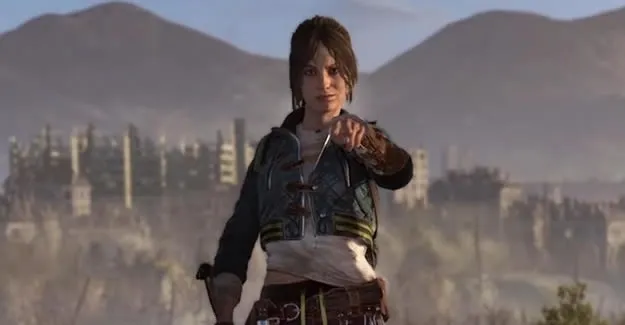Nvidia Gigabyte GeForce RTX 3050 Eagle 8G - Review
With the new GeForce RTX 3050 8G model, Nvidia has reversed the rules in the class of initial gaming graphics cards for playing in Full HD resolution. Enhanced about similar previous models, it received 8 GB of memory, RT core, and Tensor processors, in one word the most complete graphics card in this class ...
{tocify} $title={Table of Contents}
Nvidia GeForce RTX 3050 8G
Nvidia recently held a promotion of the latest and most affordable member of the GeForce Ampera graphics card series in the form of the RTX 3050 model. Since most of you are familiar enough with this graphics card, we will give you first-hand impressions and our point of view on events in the class of initial gaming models, with the primary purpose of playing in Full HD resolution.
Considering that due to the current situation and the jump in prices, this
is currently the most popular class of gaming graphics cards, as evidenced
by the data on "Steam" statistics, whereas many as 30% of users have one of
the GeForce cards from GTX 50 or GTX 60 series. The first move in this part
of the market and novelty pulled AMD with the Radeon RX 6500 XT model that
was greeted with a "knife" by the audience.
Nvidia, on the other
hand, applied a different strategy and brought a graphics card that is a
real performance improvement in this class. So, the reality of the situation
was put aside, the hardware was strengthened, and the card got over the
required 8 GB of memory. At the same time, the recommended price has been
reduced to a level that is a joy for our ears. Well, now that the latter has
nothing to do with reality, it doesn't matter, at least in the first moment
we feel better.
Elem, the new GeForce RTX 3050 directly changes all previous gaming
graphics cards from the so-called GeForce GTX 50 series: GTX 1050, GTX 1650
offering better performance and new features, but after tests, we were bold
enough to claim that this card changes absolutely all previous GTX models.
50 and 60 series that figured as ideal cards to play on 1920x1080 pixel
display monitors.
So, if you wanted to configure the initial
gaming model of the computer and "knocked" your head over whether to choose
a more affordable GTX 1650 with 4 GB of memory or be quiet and get a little
more 1660, 1660 Ti, ie the latest 1660 SUPER, it is choice of when a
headache. One is not aware of how much to spend and what to buy? Well, there
are no more such headaches, they are solved by one, the only model on offer
called GeForce RTX 3050 with 8 GB of memory.
In addition to an easier and safer decision to purchase the right gaming
graphics card model, the GeForce RTX 3050 brings gaming support for Ray
Tracing lighting effects and DLSS optimization in games to this entry-level
gaming model for the first time. So far, GeForce GTX models in this price
class did not have Ray Tracing cores or Tensor processors, while in the case
of the new Ampera model, they got the latest generation of these cores and
thus maximized the visual and complete gaming feel.
Best of all
is the fact that it is able to provide an average of 60 fps in RTX mode
using DLSS and Nvidia Image Scaling technologies. So, pure optimization is
at work, which enables maps with insufficient hardware power, with the help
of artificial intelligence and software improvements, to achieve performance
and visual quality at the level of some stronger and more expensive models.
An offer that is in a budget class cannot be ignored.
Nvidia GeForce RTX 3050 - Features
The GeForce RTX 3050 uses a GA106 graphics processor as well as the
RTX 3060 but in a version with a smaller number of Streaming Multiprocessor
(SM) units, 20 of them with a total of 2560 CUDA, 80 third-generation Tensor
cores, and 20 second-generation Ray Tracing accelerators. In other words,
the GPU in the RTX 3050 model is in terms of raw hardware power, 40% weaker
than the RTX 3060 model in the 12 GB version. We have already talked about
Ampere architecture on several occasions, and the most important thing to
remember is that it has three basic types of processors: programmable
"shader" units known as CUDA cores, Ray Tracing accelerators for RT light
effects, and Tensor processors that execute artificial intelligence
algorithms.
The reference value of the GPU base frequency is 1552
MHz, while the turbo goes up to 1775 MHz. Of course, the maximum values
will depend on the specific model and the decision of the manufacturer in
terms of the quality of workmanship and efficiency of the installed cooling
solution.
The GeForce RTX 3050 is powered via an additional 8-pin PCIe connector, and during gaming, we recorded a maximum power consumption of 130W, which in the context of the rest of the hardware needs that make up a kind of beginner gaming PC, requires a solid 550W power supply. The upper threshold of the allowed operating temperature is 93 degrees Celsius when the chip starts degrading its characteristics and performance.
Of course, the temperature is significantly lower in practice, and with our Gigabyte RTX 3050 EAGLE model, it ranges around an average of 65 degrees in a well-ventilated case to a maximum of 75 degrees after several hours of intense gaming in a standard midi tower case. This graphics card comes with two Display Port 1.4 and HDMI 2.1 connectors each.
Nvidia GeForce RTX 3050 - performance and impressions
| MB: |
ASRock X570 |
| CPU: |
AMD Ryzen 7 5800X |
| RAM: |
32GB (2x16GB) GSkill 3600 CL16 2R |
| VGA: |
Gigabyte GeForce RTX 3050 Eagle 8G |
| HDD: | Seagate Barracuda ST3000 SATA 6Gbps |
| SSD: | ADATA SU800 2TB |
| Cooler: |
AMD Wraith Prism RGB |
| PSU: | Cooler Master V1200 Platinum |
| Driver: |
GeForce Game Ready Driver 511.65 |
| OS: | Windows 11 Home 64-bit |
Performance:
In terms of gaming performance, the new GeForce RTX 3050 is convincing
compared to the GTX 1650, which directly inherits with an advantage of 42-87%,
which is more than enough reason to look in the direction of a new model if
you currently purchase a graphics card for your PC. The distance about the
stronger GTX 1660 is 15-30% in favor of the RTX 3050, which is at the same
time equal to the fastest GeForce GTX 1660 Ti and SUPER cards, somewhere even
a little faster.
Such is the situation in terms of speed and fps
average in games, and another advantage is the presence of the Ray Tracing
technique and DLSS assistance Tensor processor. In that respect, even the
strongest GTX 60s, which are currently sold at the same price - can't match it
because they lack the mentioned hardware.
Ray Tracing Gaming performance:
Otherwise, Ray Tracing's performance is quite solid with an average of 60
frames with DLSS 2.3 and adjusting the details to the optimal level, which is
somewhat unexpectedly good for this class of cards. Most importantly, it works
perfectly with a somewhat surprisingly sharp image. This is especially true
for newer titles such as Bright Memory, but also Ray Tracing classics such as
Battlefield V, Control, Call Of Duty franchise, Watch Dog Legion, and of
course Cyberpunk 2077.
In those classics without RTX mode but with
more demanding graphics "engine" like Red Dead Redemption 2 or God of War with
DLSS assistance on Ultra settings can reach an average of 50-60 frames per
second, which is a great result and feeling in the game. In addition to the
graphics processor, the presence of 8 GB of memory certainly has great
merit.
And when it comes to confronting AMD competition and the
recently promoted RX 6500 XT model, the Radeon passed as "barefoot on thorns",
although these two cards are realistically hardware-wise - a different class.
However, the recommended price of the manufacturer suggests that they are in
practically the same category.
Mostly if we leave the
combinatorics aside... GeForce RTX 3050 is 20-40% in classic titles, while in
Ray Tracing games Radeon suffered a heavy defeat except for well-optimized
games like Far Cry 6. The main reason is in twice as much the amount of
available memory, which is crucial in these situations.
In addition to the advantage of the GeForce RTX 3050, because it can take full advantage of optimization and acceleration, in addition to DLSS technology, there is also the latest - Image Scaling function. The hard work of Nvidia engineers on drivers and software has led to the fact that it is now possible to play graphically demanding titles in maximum detail with quite playful gameplay, even on 1080p models budget gaming graphics cards - which would practically suit GTX 50 and 60 models, and if just remember it used to be barely feasible and almost unusable on the RTX 2060.
To refresh your memory, DLSS is a rendering approach that employs an
artificial intelligence algorithm that can determine when to drop your
resolution and raise your frame rate for smooth animation with little
degradation, as well as sharpening the scene you're looking at in recent
versions.
With each new version, Nvidia is continuously working on
improving DLSS technology due to initial criticism regarding the problem of
the pronounced effect of scene blur when this option is activated.
In the current DLSS 2.3 version, it uses motion vectors to improve
and sharpen the details of a moving object, so that in addition to performance
and visual impression is significantly improved compared to the time when DLSS
was just promoted on the first RTX models.
On the other hand, Nvidia Image Scaling is a pure software option that does not require the existence of special hardware such as Tensor cores in the DLSS case. It works in all games and is set in the Control Panel of the Nvidia Game Ready driver. So this is a scene scaling technique were lowering the resolution results in a higher frame rate with the help of an image sharpening algorithm the biggest drawback is a side effect of using the resolution reduction technique. In games, a slider is always available for sharpening the image in real-time, by checking out the GeForce Experience tool, and activating this option is also possible from the Nvidia Control Panel or the aforementioned Experience.
GeForce RTX 3050 8G is equally good for CUDA applications. It's great in Adobe
Premiere Pro, After Effects, where models with CUDA optimization work
proverbially, and it's no less useful in Blender, Keyshot, or Redshift.
Another
important advantage is that it has the ability to hardware encode and decode
the most popular video formats it can even decode AV1 as well as other big
GeForce Ampere brothers. There is, of course, the possibility of scratching
the gameplay and desktop, and the Radeon RX 6500 XT is not able to do all that
due to the savings made.
Nvidia GeForce RTX 3050 - conclusion
Finally, we conclude that Nvidia has done a great job with the RTX 3050
8G model, provided that this graphics card model fulfills its promises of a
recommended price of $ 250. These days, a storm has risen in Germany over
where those RTX 3050 graphics cards are that are promised at the mentioned
price.
Given that this is a regulated market and that Nvidia could
be fined in a constellation for placing such information, forces have been
mobilized with manufacturers to meet certain quantities and deliver the
promised so-called budget models such as our today's tested Gigabyte RTX 3050
EAGLE, and so is also with MSI Ventus, ASUS and EVGA base models. Those
slightly better models that use quality components and cooling solutions come
at twice the price.
Nvidia has decided on a different approach in designing the initial gaming graphics card based on Ampera technology. Unlike AMD, Nvidia took a different stance and decided to improve the performance and capabilities of the base 1080p gaming graphics card and, in addition to speed, new features, finally Ray Tracing support and quite usable, which few expected. In a word, Nvidia has succeeded and made a graphics card tailored to gamers who do not have too much money. The recommended price is very attractive, even though even Nvidia is aware that it cannot influence the market situation and the demand of the "crypto-mining" population anyway, it offered the solution we expected and wanted in the least.
If you already need this kind of gaming graphics, do your best, follow the
prices, ask if something is coming in pre-sale because it pays off in the case
of this GeForce RTX 3050 card!
GeForce RTX 3050 Pros
- Performance in the class of 1080p gaming graphics cards
- RTX and DLSS support
- Nv Image Scaling works great
- Software support
- Hardware video encoding and decoding
GeForce RTX 3050 Cons
- The difference between the recommended and the market price

























